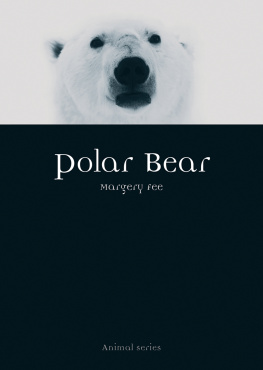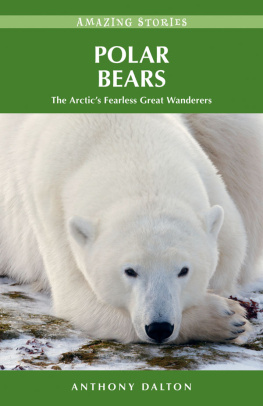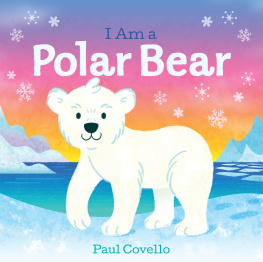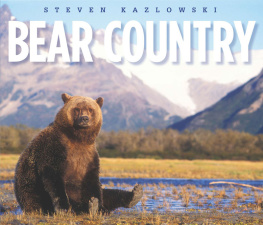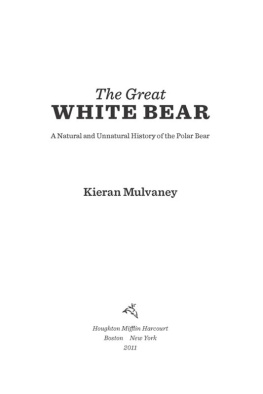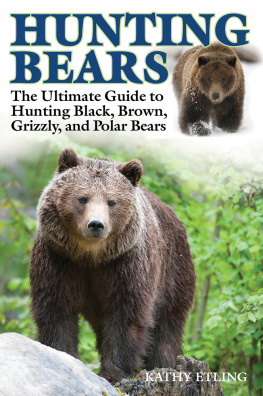Polar Bear

Animal
Series editor: Jonathan Burt
Already published
Albatross Graham Barwell Ant Charlotte Sleigh Ape John Sorenson
Badger Daniel Heath Justice Bat Tessa Laird Bear Robert E. Bieder Beaver Rachel Poliquin Bedbug Klaus Reinhardt Bee Claire Preston Beetle Adam Dodd Bison Desmond Morris
Camel Robert Irwin Cat Katharine M. Rogers Chicken Annie Potts Cockroach Marion Copeland Cow Hannah Velten Crocodile Dan Wylie Crow Boria Sax
Deer John Fletcher Dog Susan McHugh Dolphin Alan Rauch Donkey Jill Bough Duck Victoria de Rijke
Eagle Janine Rogers Eel Richard Schweid Elephant Dan Wylie
Falcon Helen Macdonald Flamingo Caitlin R. Kight Fly Steven Connor Fox Martin Wallen Frog Charlotte Sleigh
Giraffe Edgar Williams Goat Joy Hinson Goldfish Anna Marie Roos Gorilla Ted Gott and Kathryn Weir Guinea Pig Dorothy Yamamoto
Hare Simon Carnell Hedgehog Hugh Warwick Hippopotamus Edgar Williams Horse Elaine Walker Hyena Mikita Brottman
Kangaroo John Simons Kingfisher Ildiko Szabo
Leech Robert G. W. Kirk and Neil Pemberton Leopard Desmond Morris Lion Deirdre Jackson Lizard Boria Sax Llama Helen Cowie Lobster Richard J. Kin
Monkey Desmond Morris Moose Kevin Jackson Mosquito Richard Jones Moth Matthew Gandy Mouse Georgie Carroll
Octopus Richard Schweid Ostrich Edgar Williams Otter Daniel Allen Owl Desmond Morris Oyster Rebecca Stott
Parrot Paul Carter Peacock Christine E. Jackson Pelican Barbara Allen Penguin Stephen Martin Pig Brett Mizelle Pigeon Barbara Allen Polar Bear Margery Fee
Rat Jonathan Burt Rhinoceros Kelly Enright
Salmon Peter Coates Sardine Trevor Day Scorpion Louise M. Pryke Seal Victoria Dickenson Shark Dean Crawford Sheep Philip Armstrong Skunk Alyce Miller Snail Peter Williams Snake Drake Stutesman Sparrow Kim Todd Spider Katarzyna and Sergiusz Michalski Swallow Angela Turner Swan Peter Young
Tiger Susie Green Tortoise Peter Young Trout James Owen
Vulture Thom van Dooren
Walrus John Miller and Louise Miller Wasp Richard Jones Whale Joe Roman Wild Boar Dorothy Yamamoto Wolf Garry Marvin Woodpecker Gerard Gorman
Zebra Christopher Plumb and Samuel Shaw
Polar Bear
Margery Fee

REAKTION BOOKS
To Lou, for coming to see the polar bears with me, and everything else
Published by
REAKTION BOOKS LTD
Unit 32, Waterside
4448 Wharf Road
London N1 7UX, UK
www.reaktionbooks.co.uk
First published 2019
Copyright Margery Fee 2019
All rights reserved
No part of this publication may be reproduced, stored in a retrieval system or transmitted, in any form or by any means, electronic, mechanical, photocopying, recording or otherwise, without the prior permission of the publishers
Page References in the Photo Acknowledgements and
Index Match the Printed Edition of this Book.
Printed and bound in China
A catalogue record for this book is available from the British Library
eISBN 978178914171
Contents

Polar bear on an ice floe in Ukkusiksalik National Park, Nunavut, Canada.
Introduction |
In a few generations weve turned into sclerosed super-specialists, each in a niche so tight that our limbs cant stretch and our brains cant turn. Charles Foster, Being a Beast |
Weve all seen a photo of a polar bear standing alone on an ice floe: it symbolizes the warming climate and the disappearing bear. It evokes reactions of sympathy, guilt, irritation, grief or anger, sometimes more than one. These reactions are often labelled political, as if a human world without politics existed. Things get even more complicated if you start thinking about the bears perspective or that of people who live closely with polar bears in the Arctic or at the zoo. This particular bear, for example, is not lost or in trouble on that floe, which is where it has evolved to be at home. At least, it is not in trouble as long as it has a floe to stand on.
The photo cuts the bear off from any human context quite thoroughly, as many nature photos do. Images of polar bears that depict them in a radiant glow of timeless perfection in a trackless snow-world or the opposite, snarling, dying or dead vastly outnumber those that show them going about their daily life in the twenty-first century, stretched out on gravel, casing refuse dumps, interacting with zoo visitors, eviscerating seals or swinging unconscious in a net under a helicopter. It is our desires, our fears and our politics that make animals into icons and cram them with meaning.
Although polar bears were known to mid-eighteenth-century natural historians, the way in which polar bears were connected to the much more widely distributed brown bear was disputed for a long time. The polar bears official Latin name, Ursus maritimus (sea bear), was not completely fixed until 1971: for a while it was named Thalarctos, a combination of two Greek words, thalasso, sea, and arctos, bear. Some scientists did not see the polar bear as belonging to the subfamily Ursinae, which includes all other bears except the giant panda (Ailuropoda melanoleuca) and the Andean bear (Tremarctos ornatus). Now it has been proved that polar bears evolved from brown bears and still are quite closely related to them. As we will see, as they evolved, characteristics of brown bears were kept or discarded, depending on what supported survival in the extremely cold temperatures of the Arctic on a diet consisting almost exclusively of seals.

Polar bear swim, Vancouver.
Polar bears live on the interface between ice and water; for us, they live on the interface between nature and culture. Unlike many even more seriously endangered species, which include tigers, rhinos and orangutans, polar bears have always, like Further disputes arise among those who promote an expansionist commercial approach and those who would temper this approach by considering Indigenous sovereignty, animal rights or environmental protection.

Mother and cubs, Ukkusiksalik National Park, Nunavut.
The title of this book Polar Bear, rather than Polar Bears indicates the aim of the Animal series to synthesize what is known about particular species from a variety of cultural and disciplinary For the Inuit, the polar bear is exceptional in its intelligence, its

